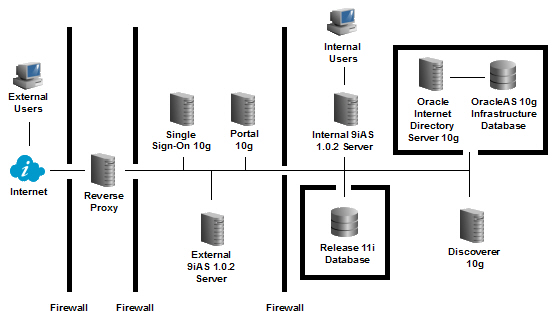I know that many of you have been waiting for this announcement for a long time, so it’s a real pleasure (and relief) to be able to tell you that Build 4.0 is finally here.
In prior releases, there were a number of challenges to integrating an OracleAS 10g instance with an E-Business Suite environment deployed in a demilitarized zone (DMZ) configuration with multiple web entry points. Some awkward workarounds existed, but they were incomplete, technically clumsy, and didn’t work consistently in all circumstances.
With this latest release, full support for OracleAS 10g + E-Business Suite + DMZ configurations is now available. This release allows you to register multiple E-Business Suite application servers (e.g. internal and external Oracle9i Application Server 1.0.2.2.2 instances) with an OracleAS 10g and Single Sign-On instance, supporting the proper redirection of traffic to the appropriate server after authentication.
This means that architectures like this are now fully supported:

Registration with SSL-Enabled Oracle Internet Directory Hosts
In prior releases, it wasn’t possible to register your E-Business Suite environment with an Oracle Internet Directory host deployed in a Secure Sockets Layer (SSL) configuration.
In this latest release, if your Oracle Internet Directory host is configured for SSL-enabled LDAP operations, you can use wallets in Oracle Wallet Manager to secure all LDAP operations.
Oracle Internet Directory Integration with RAC-Enabled Release 11i Databases
In prior releases, if your E-Business Suite database was configured to use Real Application Clusters (RAC), the synchronisation of user information between Oracle Internet Directory and FND_USER was handled by a specific database server in your RAC cluster.
If that database node failed, the synchronisation of user attributes between Oracle Internet Directory and the E-Business Suite wouldn’t failover to other database server nodes. Updates of user information in either direction would be suspended until the designated RAC database node came back online.
In this latest release, the E-Business Suite RAC service name is used when registering the Release 11i instance with Oracle Internet Directory. All user synchronisation events are handled by the E-Business Suite RAC cluster now, so if a given RAC node fails, synchronisation of user information will continue as long as other RAC nodes are still running.
References
- Installing Oracle Application Server 10g with Oracle E-Business Suite Release 11i (Note 233436.1)
- Enabling SSL with Oracle Application Server 10g and the E-Business Suite (Note 340178.1)
